50 Famous Firearms You've Got to Own: Rick Hacker's Bucket List of Guns (2015)
WINCHESTER
MODEL 1886 & MODEL 71

The Winchester Model 71 was a modern replacement for the Model 86.

The Winchester Model 1886 Extra Light Weight came out in 1896, and was available in .45-70 and .33 Winchester (shown).
You may be wondering why I have grouped these two Winchesters as one. The reason is that the Winchester Model 1886 ended up proving so popular over the years that by 1935, it was in need of an update to make it more compatible with twentieth century hunters. Here’s the complete story.
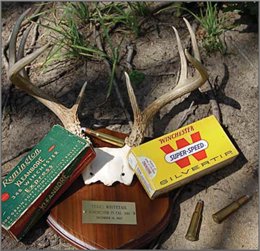
The Model 71 was only chambered in one caliber, the .348 Winchester.
Although Winchester had found a modicum of success in creating a big-game lever-action by beefing up its Model 1873 and transforming it into a much heftier Model 1876, the big gun was still hampered by the older toggle link mechanism, thus making its action too short to handle one of the most popular hunting rounds of the late nineteenth century, the .45-70 Government cartridge. It fell upon Browning firearms designing acumen to come up with a complete departure from the older Winchester lever-action design, replacing it with one that was more than capable of digesting .45-70 rounds, among others.
The Model 1886 rifle was unlike the toggle-link Winchesters of 1873 and 1876. For one, it had a stronger, beefier action, one that was eventually offered in 10 calibers ranging from .33 Winchester to .50-110. This, then, turned out to be an ultimate medium-range hunting rifle that could pretty much take care of anything that walked or crawled on this side of the hemisphere.
The product of brothers Matthew and Jonathan Browning, the Model ’86 owed its popularity to an action as smooth as warm butter yet strong as a tank, thanks to twin vertical locking bars that slid up through the receiver. When the Browning brothers showed their Model 1886 prototype to an executive at one of the country’s leading firearms dealers, Schoverling, Daly & Gales, in New York, they were told their rifle held the key to Winchester’s future. Indeed, it put Winchesters in the hands of serious big-game hunters, not the least of which was Theodore Roosevelt. In fact, it was TR who indirectly focused on one of the rifle’s faults: it was heavy. Roosevelt responded by ordering an ’86 with a half magazine to reduce the nine-pound weight of the 26-inch octagon barreled rifle.
Winchester also took note of its popular lever-action’s heft and introduced the 1886 Extra Light Weight in 1896. Chambered in .45-70 and offered with a 22-inch round tapered barrel, half magazine, hard rubber shotgun buttplate, and straight grip stock, this was also Winchester’s way of eliminating many special order options (though an optional takedown version was available). In 1902 the Extra Light Weight was also chambered for the .33 Winchester, albeit with a 24-inch barrel.
By that time all four lever-action rifles designed by Browning for Winchester had proven their versatility, easily vaulting the turn-of-the-century fence and landing well into the first part of the twentieth century. But one of those rifles was to be given a new identity, enabling it to remain in production well into the post-war years. That gun was the Model 71, a revitalized persona of the Winchester 1886, the first lever-action Browning had created for Winchester. The famous twin locking bolts, soon to be replicated in the smaller Winchester 92, were encased in the aforementioned fortress-like receiver and a smooth-as-melted-ice-cream action, which made the Model 86 a favorite with hunters, especially in chamberings such as .50-110 Express, .38-56 WCF, and, of course, .45-70.
But by the early 1930s, Winchester realized it had better do something if it was to maintain the company’s lever-action legacy among outdoorsmen. Bolt-actions were all the rage by then, and Winchester’s Models 1892 and 1894 were deer rifles at best, certainly not intended for larger game such as moose and brown bear. With the Model 1895 discontinued in 1931, Winchester was left with only one big-game lever-action, the 1886, which by that time was offered in just two calibers, .33 Winchester and .45-70. Moreover, the Winchester ’86 had become expensive to produce. While still popular, the old gun had to be reinvented for a new generation of hunters.
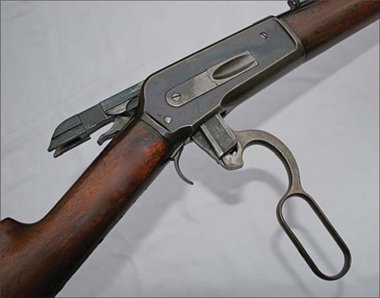
Browning’s design for the Model 1886 featured two locking bolts, making for an extremely sturdy action. Shown are the Model 86 (top) and Model 71 )(bottom).
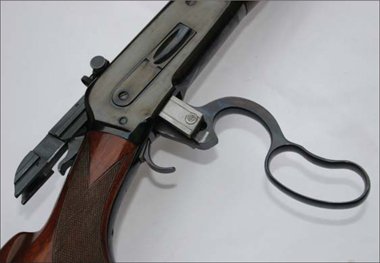
Winchester began thinking about modernizing the 1886 as soon as it discontinued the Model 95. Although 45 years old at the time, the Model 86 was still mechanically one of the strongest lever-actions ever built. It just needed some tweaking, a process that encompassed the next four years. What finally emerged, on November 2, 1935, was a gun that, with its pistol grip, checkered stock, and three-quarters magazine tube, looked every bit like a Model 86 with factory options, but it was now known as the Winchester 71. The year the 71 appeared, the 1886 was discontinued, thus ushering in the era of a lever-action that would become legendary in hunting camps for the next 23 years.
Although there was no mistaking its 1886 roots, the Model 71 was truly a redesigned gun. At the forefront, the metallurgy had been updated with forgings of Winchester’s chrome molybdenum “Proof Steel,” originally developed for John Olin’s no-cost-is-too-great Model 21 shotgun. Internally, the action had been simplified and strengthened, while still retaining its coveted butter-smooth operation. In addition, the flat springs of the 1886 were replaced by sturdier coil springs. Later versions perfected the action further, by incorporating a split trigger safety catch that prevented the hammer from being tripped until the lever was completely closed and locked. And before that could happen, the bolt had to be fully seated into the breech, making the 71 not only one of the strongest, but also one of the safest rifles of its day.
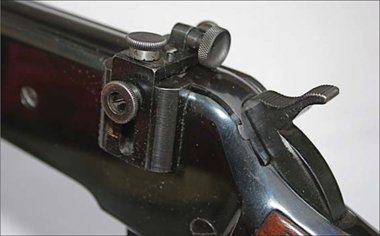
The Lyman No. 56 peep sight fitted to the receiver was one of three options on the Model 71.
Externally, the crescent buttplate of the 86 had been changed to flat, checkered steel. A factory rubber recoil pad was an extra-cost option. The wood was now beefier, featuring a checkered varnished pistol grip and a beavertail forearm, and the eight-pound rifle came equipped with quick-detachable swivels and a leather sling. A pistol grip cap, an extra option on the 1886, was now standard on the Model 71, which also incorporated a gracefully contoured lever for rapid repeat shots. A choice of a semi-buckhorn Lyman 22K open rear sight or a bolt-mounted peep was offered. Later post-war 71s did away with the sometimes disconcerting bolt-mounted peep and, instead, had a Lyman No. 56 peep sight fitted to their receivers. Underneath a 24-inch barrel was a three-quarters tubular magazine that held four cartridges. A hooded ramp front sight with steel post and bead was standard.
This initial version is referred to as the “Deluxe Model” by collectors. From January 6, 1936, until 1947, a lower priced, non-checkered variant without a pistol grip cap and sporting a 20-inch barrel was offered, which collectors now call the “Model 71 Carbine.” Up to approximately serial number 15,000, the Model 71 tang measured 37⁄8 inches in length; these early rifles are now labeled “Long Tang” models. Later guns, until the end of production, had tangs measuring 27⁄8 inches and are called “Short Tangs,” but no such designations were ever used by Winchester for this one-inch difference.
Just as impressive as the new Model 71 was the cartridge created for it, the .348 Winchester. With the exception of a very few special order early-production Model 71s in .45-70, it was the only cartridge for which the gun would be chambered—nor was the .348 Winchester ever factory chambered in any other rifle.
Initially in developing the Model 71, Winchester realized it already had an action of unprecedented strength, so it turned the company’s attention to developing a suitably strong cartridge. Rather than choose the .45-70, which was considered adequate but obsolete, they focused on the popular (at the time) .33 Winchester, which had been introduced, in 1902, specifically for the Model 1886. With a muzzle velocity of 2,220 fps, the .33 WCF had already proven its elk-busting capabilities. It also had a better trajectory than the rainbow-arching .45-70. Any new cartridge would have to be noticeably more powerful.
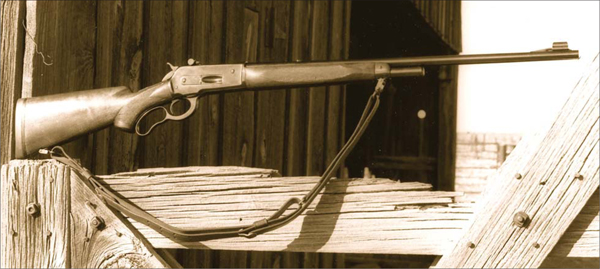
The author has hunted with this Model 71 all over the West.
The .348 Winchester sported a necked-down case based upon the old .50-110 blackpowder cartridge originally developed for the Model 86 in 1899. Just as the Model 71 was, in reality, an improved 86, the .348 was basically an improved .33 Winchester. The factory loaded cartridge was initially offered by Winchester and Remington in 150-, 200-, and 250-grain bullets, although the 150-grain loading proved to be ballistically inferior. Consequently, it was the 200- and 250-grain slugs that found favor with big-game hunters. The 250-grain bullet was preferred for its greater knockdown power, but with a muzzle velocity of 2,320 fps, it also produced noticeably more recoil. Thus, most hunters compromised by opting for the 200-grain bullet. In 1962, the 150 and 250 loadings were discontinued, but a 200-grain Silvertip is still offered by Winchester. In addition, Buffalo Bore (www.buffalobore.com) produces a 250-grain jacketed flat-nose, which would be my choice for brown bear and similar dangerous game.
With its tubular magazine necessitating blunt-nosed bullets, the effective range of the open-sighted Model 71 was about 200 yards; suffice it to say, anything on the North American continent within that range would be meat in the pot. It is hardly surprising that the Model 71 was enthusiastically embraced by hunters, and it remains both a collectable and a working rifle today. It is particularly coveted in Alaska, where many of these guns have been converted to wildcats such as the .450 Alaskan.
Unfortunately, high manufacturing costs and changing times led to the discontinuance of the Model 71 in 1958, with 47,254 rifles produced. Yet demand for the smooth-shooting, hard-hitting lever gun resulted in Browning offering a limited run of Model 1886 rifles and carbines from 1992 to 1993, and Model 71 rifles and carbines from 1987 to 1989, all of which proves that even though the Model 71 and its predecessor, the Model 86, have been discontinued, they are far from obsolete. As both a hunting gun and a collectable that evokes thick forests, crisp autumn days, and big racks, they both belong on my bucket list.
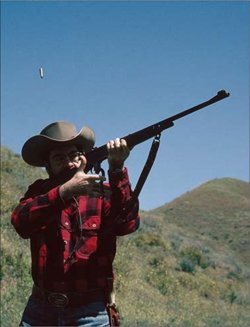
The Model 71 maintains the fast shooting characteristics of the Model 1886.
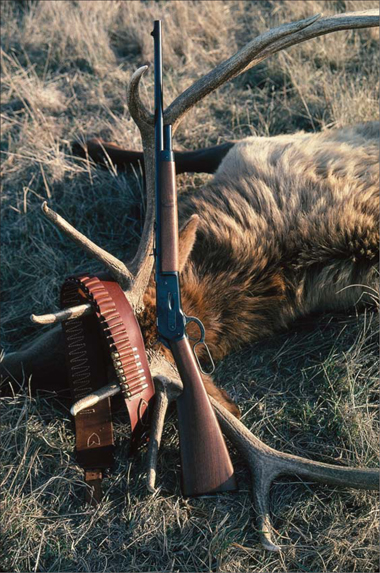
The author took this magnificent six-point elk with a single shot from his Miroku-made Winchester 86 Lightweight, using a 250-grain Buffalo Bore bullet.